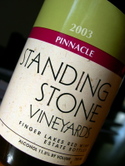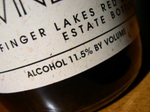 Today is Wine Blogging Wednesday, hosted by wine podcaster extraordinaire Tim Elliott of Winecast. Tim has participated in most every WBW from its inception, so it’s great to finally have him hosting. And, he came up with a great theme.
Today is Wine Blogging Wednesday, hosted by wine podcaster extraordinaire Tim Elliott of Winecast. Tim has participated in most every WBW from its inception, so it’s great to finally have him hosting. And, he came up with a great theme.
The theme: Find a red wine with 12.5% ABV or less
More and more, these types of wines are the exception rather than the rule. Is it global warming? Is it winemakers catering to certain critics?
Regardless, I knew I’d have no problem finding a wine for this event. Long Island wines tend to fall in the 12%-13% range in most vintages. So, finding a local merlot at 12.5% wasn’t going to be a challenge.

Rather than take the easy way, I thought I’d find the lowest ABV in my stash of New York wines. After digging through a bunch of 12-ish% wines, I came upon a bottle of Standing Stone Vineyards 2003 Pinnacle ($21), a Bordeaux-style blend, that comes in at only 11.5% ABV.
Standing Stone Vineyards is located in Hector, NY on the eastern shore of Seneca Lake in the Finger Lakes region of New York. The vineyard was purchased in 1991 by Tom and Marti Macinski, with their first vintage happening a couple years later in 1993. They made 800 cases of wine that year and are now up to 6500 cases.
I must admit, I’ve tasted a fair number of Finger Lakes reds and very few stand out in my memory. The region is even cooler than Long Island, so ripeness can be an issue. Most reds tend to be light on flavor (and body) and sometimes winemakers use more oak than barely-ripe grapes can handle.
This particularly wine is a blend of 85% cabernet sauvignon, 10% merlot and 5% cabernet franc. The cabernet sauvignon was harvested November 08, 2003 at 21.0 Brix. Fermented using Barolo, BM45 and T73 yeasts, all lots went through a strict regimen of four to five punch-downs per day to maximize color and flavor extraction. Some lots were pressed off before dryness and placed in barrels to complete the fermentation. The rest of the lots went into barrels upon completion of fermentation or after an extended maceration time of 10-14 days.
All lots were pressed in a small (¾ ton) basket press and the cabernet sauvignon was placed in newer French and American oak barrels for 18 months before carefully selected barrels were blended.

The wine’s moderate nose is mostly black cherry with some under-ripe ‘green’ notes as well. On the palate, medium-light body offers cherry, chocolate and red delicious apple flavors with soft, light tannins and light acidity. Overall, it’s not complex but I’m glad they didn’t overdo the oak — the fruit flavors are pleasant, if a little underripe.
Would I drink it again? Ask me again tomorrow. I’m going to re-taste the wine tonight to see how it’s changed. It is one of the better Finger Lakes reds that I’ve had.
Thanks to Tim for hosting this month’s vintage of WBW. And keep an eye out for July’s announcement.
